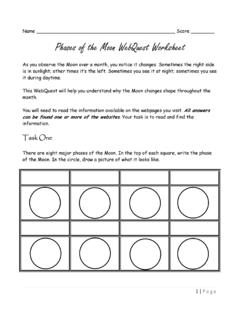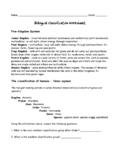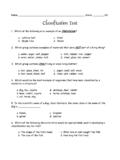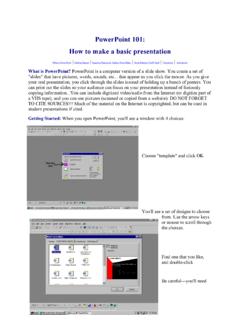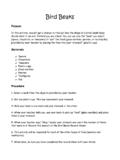Transcription of Microbe Wanted Poster - Mr. Hill's Science Website
1 Microbe Wanted Poster (modified from an activity at Access Exchange) Assignment Make a Wanted Poster for one of the diseases listed below. Include the following information: Hand drawn picture of your Microbe . Write the name of the Microbe and if it is bacterium, fungus, protist. Description of the disease it causes. How you get the disease (eating, breathing, through the air, touch, etc.) What happens to the victim. What are the symptoms. Is it considered armed and dangerous? rate the degree of damage caused (makes you sick, can kill you, etc.). How is it treated. Poster Rubric CATEGORY 4 3 2 1 Required Elements The Poster includes all required elements as well as additional information. All required elements are included on the Poster . All but 1 of the required elements are included on the Poster .
2 Several required elements were missing. Knowledge Gained Student can accurately answer all questions related to facts in the Poster and processes used to create the Poster . Student can accurately answer most questions related to facts in the Poster and processes used to create the Poster . Student can accurately answer about 75% of questions related to facts in the Poster and processes used to create the Poster . Student appears to have insufficient knowledge about the facts or processes used in the Poster . Content - Accuracy All facts displayed on the Poster are correct. All but one fact displayed on the Poster is correct. 2-3 facts displayed on the Poster are incorrect. Four or more facts displayed on the Poster are incorrect. Wanted Name of Microbe Draw picture of Microbe Required information in this section.
3 Name _____ Name must be in bottom right corner! 1 Botulism (bot-u-liz-um) What is Botulism? Botulism is a rare but serious illness caused by a nerve toxin that is produced by bacteria (Clostridium botulinum). How do you get botulism? You get botulism by eating foods that contain the botulism toxin. All forms of botulism can be fatal and are considered medical emergencies. Food borne botulism can be especially dangerous because many people can be poisoned by eating a contaminated food. What are botulism s symptoms? Double vision, blurred vision, drooping eyelids, slurred speech, difficulty swallowing, dry mouth, and muscle weakness. If untreated, these symptoms may progress to cause paralysis of the arms, legs, trunk and respiratory muscles. In food borne botulism, symptoms generally begin 18 to 36 hours after eating a contaminated food, but they can occur as early as 6 hours or as late as 10 days.
4 Treatment If caught early enough, shots of antitoxin are given to break down the botulism s toxin (poison). If you have breathing problems, you may need a ventilator to help you breathe. 2 Whooping Cough What is whooping cough? This is a disease of the respiratory tract, highly contagious, and a vaccine-preventable, bacterial (Bordetella pertussis) infection. How do you get whooping cough? The infection is spread through the air by respiratory droplets from an infected person (direct contact). If you are going to get it, you usually get it 7 days after you were exposed to the disease. What are the symptoms of whooping cough? Symptoms are a runny nose; cough (severe); slight fever (102o or lower); severe coughing attacks that can end in a high pitched, crowing sound when inhaling or ends in a high-pitched whoop ; a coughing spell that may end in a momentary loss of consciousness, or a cough with difficulty in breathing; vomiting during a severe bout of coughing; diarrhea, and chocking spells in infants.
5 Treatment Bed rest and antibiotics are prescribed. 3 Cholera (call-er-a) What is cholera? Cholera is an acute, diarrheal illness caused by infection of the intestine with bacteria (Vibrio cholera). How do you get cholera? A person may get cholera by drinking water or eating food contaminated with the cholera bacterium. In an epidemic, the source of the contamination is usually the feces of an infected person. Shellfish eaten raw have been a source of cholera, and a few persons in the United States have contracted cholera after eating raw or undercooked shellfish from the Gulf of Mexico. Casual contact with an infected person is not a risk for becoming ill. What are the symptoms of cholera? The infection is often mild or without symptoms, but sometimes it can be severe.
6 Approximately one in 20 infected persons have severe disease characterized by profuse watery diarrhea, vomiting, and leg cramps. In these persons, rapid loss of body fluids leads to dehydration and shock. Without treatment, death can occur within hours. Treatment Increasing fluids is essential. Antibiotics can also help. 4 Typhoid (tie-foid) Fever What is typhoid fever? Typhoid fever is a life-threatening illness caused by bacteria (Salmonella typhi). How do you get typhoid fever? The bacteria live only in humans. You can get typhoid fever if you eat food or drink beverages that have been handled by a person who is shedding the bacteria or if sewage contaminated with bacteria gets into the water you use for drinking or washing food. Therefore, typhoid fever is more common in areas of the world where hand washing is less frequent and water is likely to be contaminated with sewage.
7 What are the symptoms of typhoid fever? Persons with typhoid fever usually have a sustained fever as high as 103 to 104 F. They may also feel weak, or have stomach pains, headache, or loss of appetite. In some cases, patients have a rash of flat, rose-colored spots. Treatment Using antibiotics, increasing fluids, and a healthy diet. 5 Salmonella What is salmonella? Salmonella is a type of food poisoning caused by bacteria (Salmonella enteritidis). How do I get salmonella? Salmonella are usually transmitted to humans by eating foods contaminated with animal feces. Contaminated foods usually look and smell normal. Contaminated foods are often of animal origin, such as beef, poultry, milk, or eggs, but all foods, including vegetables may become contaminated. Many raw foods of animal origin are frequently contaminated, but fortunately, thorough cooking kills Salmonella.
8 Food may also become contaminated by the unwashed hands of an infected food handler, who forgot to wash his or her hands with soap after using the bathroom. Transmission may also occur by handling pet turtles, baby chicks, frogs and snails that harbor the Salmonella bacteria. What are the symptoms of salmonella? Symptoms can vary greatly from person to person, may occur 12-72 hours after ingestion of contaminated food or water and may last 4-7 days. Most individuals experience two or more of the following symptoms: onset of severe headaches, abdominal cramps, diarrhea, nausea, vomiting, low-grade fever and muscle aches. Some individuals experience no symptoms but harbor the bacteria in their intestines and are at risk of spreading it to other individuals. A diagnosis of Salmonella infection is made by testing a poop specimen for the presence of the bacteria.
9 Treatment Usually no antibiotics are given because it last such a short time. Rest and drinking plenty of fluids is usually the best course. 6 E. coli What is E. coli? E. coli (Escherichia coli) are bacteria that normally live in the intestines of humans and animals. Although, most of these bacteria are harmless, several are known to produce toxins that can cause diarrhea and food poisoning. How do I get E. coli? The bacteria are acquired by eating food containing the bacteria. The bacteria live in the intestines of some healthy cattle, and contamination of the meat may occur in the slaughtering process. Eating meat that is rare or inadequately cooked is the most common way of getting the infection. Person-to-person transmission can occur if infected people do not wash their hands after using the toilet.
10 What are the symptoms of E. coli? Symptoms start about 7 days after you are infected with the germ. The first sign is severe abdominal cramps that start suddenly. After a few hours, watery diarrhea starts. The diarrhea causes your body to lose fluids and electrolytes (dehydration). This makes you feel sick and tired. The watery diarrhea lasts for about a day. Then the diarrhea changes to bright red bloody poop. The infection makes sores in your intestines, so the poop become bloody. Bloody diarrhea lasts for 2 to 5 days. You might have 10 or more bowel movements a day. Some people say their stools (#2) are "all blood and no poop." You may have a mild fever or no fever. You may also have nausea or vomiting. If you have any of these symptoms - watery, bloody diarrhea, cramps, fever, nausea or vomiting - try to get to your doctor right away.
